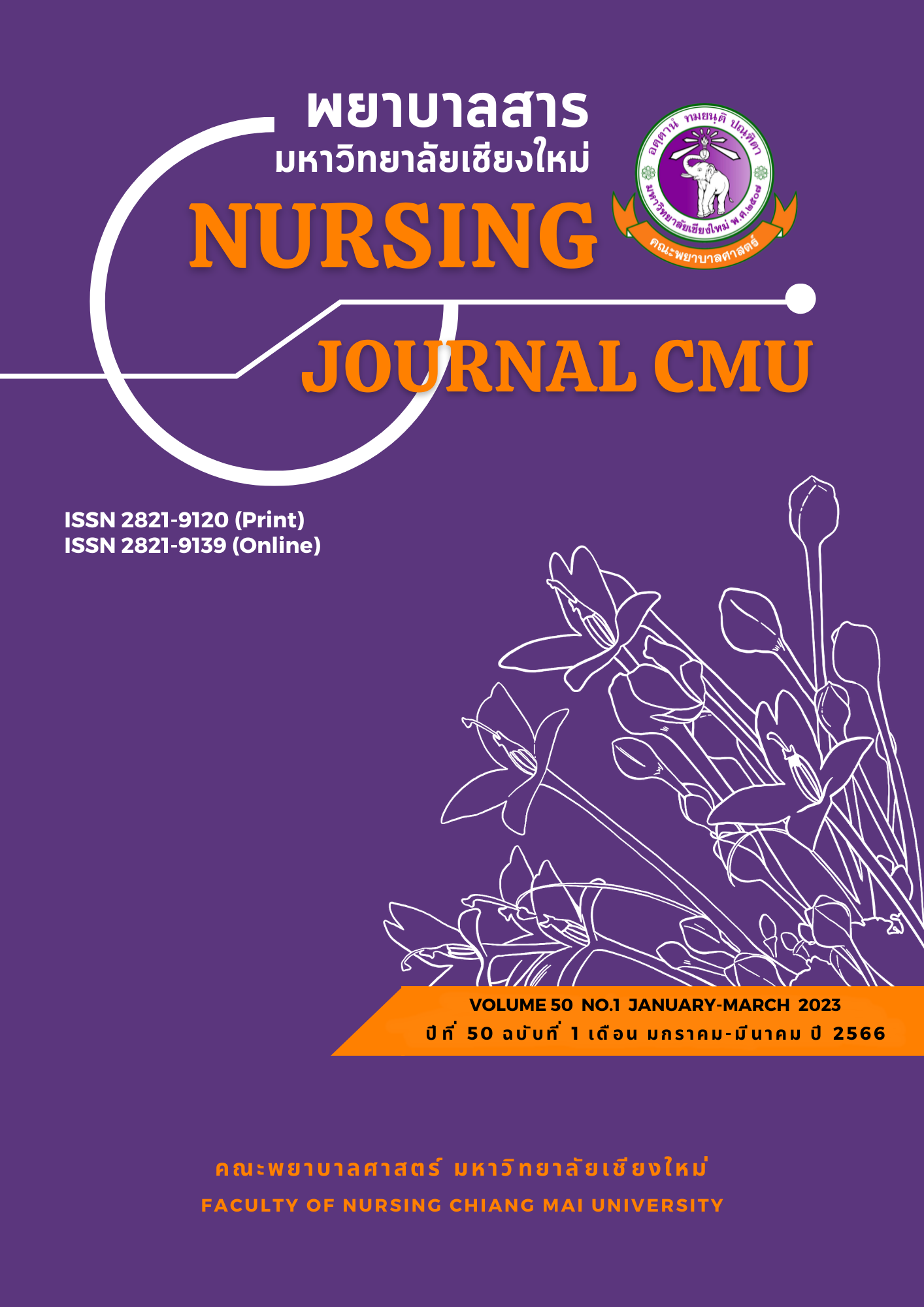ผลของโปรแกรมการจัดการตนเองต่อสมรรถภาพปอดและอาการหายใจลำบาก ของผู้ป่วยโรคปอดอุดกั้นเรื้อรัง อำเภอสวรรคโลก จังหวัดสุโขทัย
คำสำคัญ:
การจัดการตนเอง, สมรรถภาพปอด, โรคปอดอุดกั้นเรื้อรัง, อาการหายใจลำบากบทคัดย่อ
โรคปอดอุดกั้นเรื้อรังกระทบต่อการดำเนินชีวิตของผู้ป่วยเนื่องจากอาการกำเริบ และสมรรถภาพปอดที่ค่อย ๆ เสื่อมลง การสนับสนุนการจัดการตนเองช่วยส่งเสริมความสามารถของผู้ป่วยในการจัดการโรค ปรับเปลี่ยนพฤติกรรมและนำไปสู่ผลลัพธ์ที่ดี การวิจัยแบบกึ่งทดลองนี้มีวัตถุประสงค์ เพื่อศึกษาผลของโปรแกรมการจัดการตนเองต่อสมรรถภาพปอดและอาการหายใจลำบากของผู้ป่วยโรคปอดอุดกั้น กลุ่มตัวอย่างเป็นผู้ป่วยโรคปอด
อุดกั้นเรื้อรัง คัดเลือกกลุ่มตัวอย่างแบบเฉพาะเจาะจง จำนวน 60 คน และใช้วิธีการสุ่มแบบง่ายเพื่อจัดเข้ากลุ่มทดลองและกลุ่มควบคุม กลุ่มละ 30 คน กลุ่มทดลองเข้าร่วมโปรแกรมการจัดการตนเอง ส่วนกลุ่มควบคุมได้รับการพยาบาลตามปกติ เครื่องมือที่ใช้ในการเก็บรวบรวมข้อมูล ได้แก่ 1) แบบบันทึกข้อมูลทั่วไป 2) แบบประเมินอาการหายใจลำบาก และ 3) เครื่องสไปโรมิเตอร์แบบเคลื่อนที่ ค่าความเชื่อมั่นของแบบประเมินอาการหายใจลำบากเท่ากับ 0.78 และเครื่องสไปโรมิเตอร์แบบเคลื่อนที่ได้รับการสอบเทียบตามมาตรฐานก่อนใช้งาน วิเคราะห์ข้อมูลโดยใช้สถิติพรรณนา สถิติ t-test สถิติ Mann-Whitney U test และสถิติ repeated measure ANOVA
ผลการวิจัยพบว่า หลังการทดลอง อาการหายใจลำบากของกลุ่มทดลองดีกว่ากลุ่มควบคุมอย่างมีนัยสำคัญทางสถิติ (p < .05) สมรรถภาพปอดดีกว่ากลุ่มควบคุมแต่ไม่แตกต่างกันอย่างมีนัยสำคัญทางสถิติ เมื่อเปรียบเทียบภายในกลุ่มทดลอง พบว่า หลังการทดลอง สมรรถภาพปอดและอาการหายใจลำบากดีขึ้นกว่าก่อนทดลอง และยังคงดีขึ้นในระยะติดตามอย่างมีนัยสำคัญทางสถิติ (p < .05)
ผลการวิจัยนี้แสดงให้เห็นว่า โปรแกรมการจัดการตนเองสามารถนำไปประยุกต์ใช้เพื่อส่งเสริมสมรรถภาพปอด และลดอาการหายใจลำบากของผู้ป่วยโรคปอดอุดกั้นเรื้อรังได้
References
Buist, A. S., McBurnie, M. A., Vollmer, W. M., Gillespie, S., Burney, P., Monnino, D. M., … Nizankowska-Mogilnicka, E. (2007). International variation in the prevalence of COPD (The Bold study): A population-based prevalence study. Lancet, 370(9585), 741-750. doi: 10.1016/S0140-6736(07)61377-4
Burns, N., & Grove, S. K. (2005). The practice of nursing research conduct, critique, & utilization (5th ed.). Philadelphia: Elsevier Saunders.
Chantaro, N., Khupantawee, N., & Chinnawong, T. (2018). Effects of self-management support program on ability to manage symptom and dyspnea among patients with chronic obstructive pulmonary disease. Songklanagarind Journal of Nursing, 38(3), 25-37. (in Thai)
Choi, J. Y., Chung, H-I. C., & Han, G. (2013). Patient outcomes according to COPD action plan adherence. Journal of Clinical Nursing, 23(1), 883-891. doi: 10.1111/joen.12293
Chouyhoa, T. (2015). Effects of a self-management support program in patients with chronic obstructive pulmonary disease on knowledge, self-management behaviors, dyspnea and lung function (Unpublished master’s thesis), Burapha University, Thailand. (in Thai)
Duangta, N., Liangchawengwong, S., & Sngunrungsirikul, S. (2017). Impact of a breathing exercise self-efficacy programme on self-efficacy on chronic obstructive pulmonary disease patients. Thai Journal of Nursing Council, 32(2), 95-110. (in Thai)
Ekkamart, B., Matchim, Y., Mamom, J., & Sangsayunh, P. (2021). Chronic obstructive pulmonary disease patients’ symptomatic experiences. Journal of Thailand Nursing and Midwifery Council, 36(2), 80-92. (in Thai)
Global Initiative for Chronic Obstructive Lung Disease Committee. (2023). Global strategy for the diagnosis, management, and prevention of COPD: 2023 Report. Retrieved from https://goldcopd.org/wp-content/uploads/2022/ 12/GOLD-2023-ver-1.1-2Dec2022_ WMV.pdf
Health Information Unit, Strategy and Planning Division, Ministry of Public Health. (2020). Public Health Statistics A. D. 2020. Retrieved from https://bps.moph.go.th/new_bps/sites/default/files/2563_0.pdf
Jaikum, P., Tamdee, D., & Aungwattana, S. (2020). Factors related to self-management behaviors of highlanders with chronic obstructive pulmonary disease. Nursing Journal, 47(4), 142-153. (in Thai)
Kamthong, S., Supametaporn, P., & Jantarawijit, Y. (2019). Factors predicting acute exacerbation in patients with chronic pulmonary disease. Nursing Journal, 46(1), 126-136. (in Thai)
Leelarungrayub, D. (2014). Clinical chest physiotherapy (3rd ed.). Bangkok: Thammasart University Book Center. (in Thai)
Luangaram, S., Srisopa, P., & Chanavirut, R. (2018). Home-based exercise in COPD patients. Journal of Medical Technology and Physical Therapy, 30(2), 226-236. (in Thai)
Lorig, K. R., & Holman, H. R. (2003). Self-management education: History, definition, outcomes, and mechanisms. Annals of Behavioral Medicine, 26(1), 1-7.
Makanut, S. (2019). Chronic obstructive pulmonary disease. In S. Makanut & S. Sirilak (Eds.), Naresuan Medicine’s Textbook (p.41-59). Phitsanulok: Department of Medicine, Faculty of Medicine, Naresuan University. (in Thai)
Mautsa, T., Danyuthasilpe, C., Tangkawanich, T., & Pachanban, P. (2016). Effects of Roy theory nursing program on adaptation behavior and dyspnea in patient with chronic obstructive pulmonary disease. Journal of Nursing and Health Sciences, 10(2), 190-200. (in Thai)
Moharmed, S. A. (2019). The effects of positioning and pursed-lip breathing exercise on dyspnea and anxiety status in patients with chronic obstructive pulmonary disease. Journal of Nursing Education and Practice, 9(6), 41-51. doi: 10.5430/jnep.v9n6p41
Parshal, M. B., Schwartzein, R. M., Adams, L., Banzett, R. B., Manning, H. L., Bourbeau, J., … O’Donnell. (2012). An official American Thoracic Society Statement: Update on the mechanisms, assessment, and management of dyspnea. American Journal of Respiratory and Critical Care Medicine, 185(4), 435-452. dio: 10.1164/rccm.201111-2042ST
Pickstock, S. (2017). Breathlessness at end of life: What community nurses should know. Journal of Community Nursing, 31(5), 74-75.
Polit, D. F., & Hungler, B. P. (1999). Nursing research: Principles and methods. Phildelphia: JB Lippincott.
Ruan, H., Zhang, H., Wang, J., Zhao, H., Han, W., & Li, J. (2023). Readmission rate for acute exacerbation of chronic obstructive pulmonary disease: A systematic review and meta-analysis. Respiratory Medicine, 206, 1-12.
Srisatidnarakul, B. (2010). The methodology in nursing research. Bangkok: U&I intermedia. (in Thai)
Sukhothai Provincial Health Office. (2020). Health data center. Retrieved from https://sti.hdc.moph.go.th/hdc/main/index,php#
Thanawong, L., Nantachaipan, P., & Soivong, P. (2016). Effects of a self-management promotion in pulmonary rehabilitation on function capacity and health care utilization among persons with chronic obstructive pulmonary disease. Nursing Journal, 43(2), 45-56. (in Thai)
Thoracic Society of Thailand under Royal Patronage. (2017). Suggestion about treatment and care for patients with chronic obstructive pulmonary disease A.D.2017. Bangkok: Author. (in Thai)
Van der Molen, T., Miravitlles, M., & Kocks, J. W. (2013). COPD management: Role of symptom assessment in routine clinical practice. International Journal of Chronic Obstructive Pulmonary Disease, 8, 461-471.
Wintachai, T., & Ua-kit, N. (2018). Effects of a self-management program on pulmonary function in chronic obstructive pulmonary disease patients. Journal of Nursing Science Chulalongkorn University, 30(2), 124-135. (in Thai)
Wongderm, A., & Duangpaeng, S. (2014). Factors influencing function performance among patients with chronic obstruction pulmonary disease. Thai Pharmaceutical and Health Science Journal, 9(3), 120-128. (in Thai)
Downloads
เผยแพร่แล้ว
How to Cite
ฉบับ
บท
License
Copyright (c) 2023 พยาบาลสาร

This work is licensed under a Creative Commons Attribution-NonCommercial-NoDerivatives 4.0 International License.
บทความที่ได้รับการตีพิมพ์เป็นลิขสิทธิ์ของวารสารพยาบาลสาร
ข้อความที่ปรากฏในบทความแต่ละเรื่องในวารสารวิชาการเล่มนี้เป็นความคิดเห็นส่วนตัวของผู้เขียนแต่ละท่านไม่เกี่ยวข้องกับมหาวิทยาลัยเชียงใหม่ และคณาจารย์ท่านอื่นๆในมหาวิทยาลัยฯ แต่อย่างใด ความรับผิดชอบองค์ประกอบทั้งหมดของบทความแต่ละเรื่องเป็นของผู้เขียนแต่ละท่าน หากมีความผิดพลาดใด ๆ ผู้เขียนแต่ละท่านจะรับผิดชอบบทความของตนเองแต่ผู้เดียว





